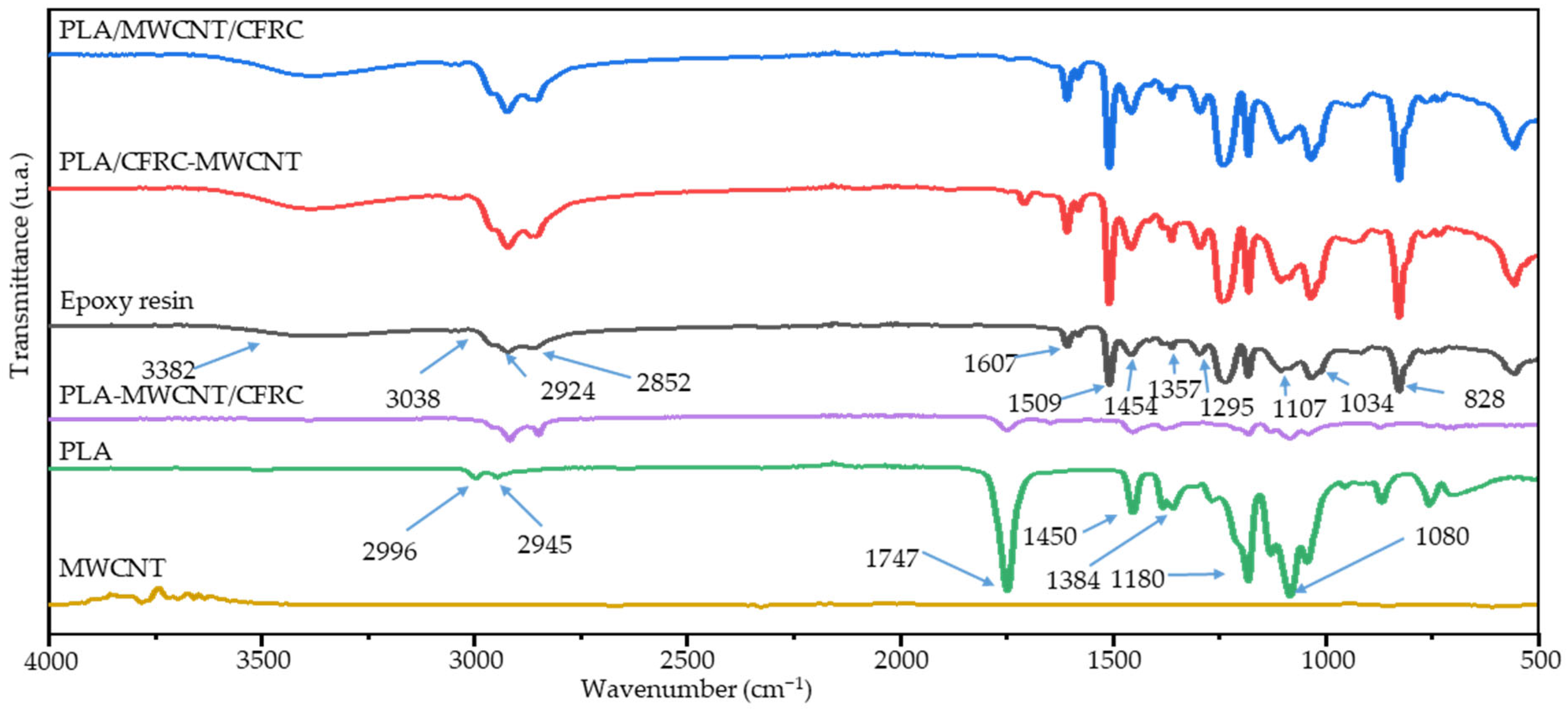Enhancing Polylactic Acid/Carbon Fiber-Reinforced Biomedical Composites (PLA/CFRCs) with Multi-Walled Carbon Nanotube (MWCNT) Fillers: A Comparative Study on Reinforcing Techniques
Abstract
:1. Introduction
2. Materials and Methods
2.1. Materials
2.2. Synthesis of MWCNTs and Manufacturing of Composite Materials with MWCNT Fillers
2.2.1. Synthesis of Nanotubes by the Spray-Pyrolysis Method
2.2.2. Manufacturing of 3D-Printed Plates with PLA
2.2.3. Composite of PLA/CFRC
2.2.4. Fusion-Blended Composite of PLA and MWCNT (PLA-MWCNT/CFRC)
2.2.5. Composite with Ultrasonic Dispersion of Carbon Nanotubes in Epoxy Resin (PLA/CFRC-MWCNT)
2.2.6. Composite with Interlaminar Spray-Coating (PLA/MWCNT/CFRC)
2.3. Characterization Techniques
2.3.1. Raman Spectroscopy
2.3.2. Scanning Electron Microscopy (SEM)
2.3.3. Fourier Transform Infrared Spectroscopy (FTIR)
2.3.4. Thermal Analysis (TGA/DSC)
2.3.5. Mechanical Characterization
2.3.6. Cytotoxicity Assays
Cell Culture
Cell Viability Assay
Statistical Analysis
3. Results and Discussions
3.1. Raman Spectroscopy of MWCNTs
3.2. Scanning Electron Microscopy (SEM) of MWCNTs
3.3. Analysis by Fourier Transform Infrared Spectroscopy (FTIR) Polymer Matrix
3.4. Thermal Analysis (TGA-DSC)
3.5. Mechanical Properties of the Nanocomposites
3.6. Morphological Analysis
3.7. Cell Viability Assay
4. Conclusions
Author Contributions
Funding
Data Availability Statement
Acknowledgments
Conflicts of Interest
References
- Sheoran, A.J.; Kumar, H.; Arora, P.K.; Moona, G. Bio-Medical Applications of Additive Manufacturing: A Review. Procedia Manuf. 2020, 51, 663–670. [Google Scholar] [CrossRef]
- Saeed, K.; McIlhagger, A.; Harkin-Jones, E.; McGarrigle, C.; Dixon, D.; Ali Shar, M.; McMillan, A.; Archer, E. Characterization of Continuous Carbon Fibre Reinforced 3D Printed Polymer Composites with Varying Fibre Volume Fractions. Compos. Struct. 2022, 282, 115033. [Google Scholar] [CrossRef]
- Wang, X.; Jiang, M.; Zhou, Z.; Gou, J.; Hui, D. 3D Printing of Polymer Matrix Composites: A Review and Prospective. Compos. Part B Eng. 2017, 110, 442–458. [Google Scholar] [CrossRef]
- Katoozian, H.; Davy, D.T.; Arshi, A.; Saadati, U. Material Optimization of Femoral Component of Total Hip Prosthesis Using Fiber Reinforced Polymeric Composites. Med. Eng. Phys. 2001, 23, 505–511. [Google Scholar] [CrossRef]
- Agarwal, T.; Chiesa, I.; Presutti, D.; Irawan, V.; Vajanthri, K.Y.; Costantini, M.; Nakagawa, Y.; Tan, S.A.; Makvandi, P.; Zare, E.N.; et al. Recent Advances in Bioprinting Technologies for Engineering Different Cartilage-Based Tissues. Mater. Sci. Eng. C 2021, 123, 112005. [Google Scholar] [CrossRef]
- Mittal, G.; Rhee, K.Y.; Mišković-Stanković, V.; Hui, D. Reinforcements in Multi-Scale Polymer Composites: Processing, Properties, and Applications. Compos. Part B Eng. 2018, 138, 122–139. [Google Scholar] [CrossRef]
- Lee, J.H.; Park, S.H.; Kim, S.H.; Ito, H. Replication and Surface Properties of Micro Injection Molded PLA/MWCNT Nanocomposites. Polym. Test. 2020, 83, 106321. [Google Scholar] [CrossRef]
- Yang, C.; Chen, S.; Wang, J.; Zhu, T.; Xu, G.; Chen, Z.; Ma, X.; Li, W. A Facile Electrospinning Method to Fabricate Polylactide/Graphene/MWCNTs Nanofiber Membrane for Tissues Scaffold. Appl. Surf. Sci. 2016, 362, 163–168. [Google Scholar] [CrossRef]
- Yang, L.; Li, S.; Zhou, X.; Liu, J.; Li, Y.; Yang, M.; Yuan, Q.; Zhang, W. Effects of Carbon Nanotube on the Thermal, Mechanical, and Electrical Properties of PLA/CNT Printed Parts in the FDM Process. Synth. Met. 2019, 253, 122–130. [Google Scholar] [CrossRef]
- Sanusi, O.M.; Benelfellah, A.; Terzopoulou, Z.; Bikiaris, D.N.; Aït Hocine, N. Properties of Polylactide Reinforced with Montmorillonite/Multiwalled Carbon Nanotube Hybrid. Mater. Today Proc. 2021, 47, 3247–3250. [Google Scholar] [CrossRef]
- Cobos, C.; Conejero, A.; Fenollar, O.; Ferrándiz, S. Influence of the Addition of 0.5 and 1% in Weight of Multi-Wall Carbon Nanotubes (MWCNTs) in Poly-Lactic Acid (PLA) for 3D Printing. Procedia Manuf. 2019, 41, 875–881. [Google Scholar] [CrossRef]
- Chaudhry, M.S.; Czekanski, A.; Zhu, Z.H. Characterization of Carbon Nanotube Enhanced Interlaminar Fracture Toughness of Woven Carbon Fiber Reinforced Polymer Composites. Int. J. Mech. Sci. 2017, 131–132, 480–489. [Google Scholar] [CrossRef]
- Urtekin, G.; Aytac, A. The Effects of Multi-Walled Carbon Nanotube Additives with Different Functionalities on the Properties of Polycarbonate/Poly (Lactic Acid) Blend. J. Polym. Res. 2021, 28, 180. [Google Scholar] [CrossRef]
- Rathinavel, S.; Priyadharshini, K.; Panda, D. A Review on Carbon Nanotube: An Overview of Synthesis, Properties, Functionalization, Characterization, and the Application. Mater. Sci. Eng. B Solid-State Mater. Adv. Technol. 2021, 268, 115095. [Google Scholar] [CrossRef]
- Mittal, G.; Dhand, V.; Rhee, K.Y.; Park, S.J.; Lee, W.R. A Review on Carbon Nanotubes and Graphene as Fillers in Reinforced Polymer Nanocomposites. J. Ind. Eng. Chem. 2015, 21, 11–25. [Google Scholar] [CrossRef]
- Annu, A.; Bhattacharya, B.; Singh, P.K.; Shukla, P.K.; Rhee, H.W. Carbon Nanotube Using Spray Pyrolysis: Recent Scenario. J. Alloys Compd. 2017, 691, 970–982. [Google Scholar] [CrossRef]
- Ebbesen, T.W.; Lezec, H.J.; Hiura, H.; Bennett, J.W.; Ghaemi, H.F.; Thio, T. Electrical Conductivity of Individual Carbon Nanotubes. Nature 1996, 382, 54–56. [Google Scholar] [CrossRef]
- Fenta, E.W.; Mebratie, B.A. Advancements in Carbon Nanotube-Polymer Composites: Enhancing Properties and Applications through Advanced Manufacturing Techniques. Heliyon 2024, 10, e36490. [Google Scholar] [CrossRef]
- Cardona Salcedo, M.A.; Oropeza Guzmán, M.T.; Moreno Grijalva, G.I.; Zizumbo López, A.; Paz González, J.A.; Gochi Ponce, Y. Polylactic Acid/Multi Walled Carbon Nanotubes (PLA/MWCNT) Nanocomposite for 3D Printing of Medical Devices. Rev. Cienc. Tecnológicas 2021, 4, 388–398. [Google Scholar] [CrossRef]
- Aguilar-Elguézabal, A.; Antúnez, W.; Alonso, G.; Delgado, F.P.; Espinosa, F.; Miki-Yoshida, M. Study of Carbon Nanotubes Synthesis by Spray Pyrolysis and Model of Growth. Diam. Relat. Mater. 2006, 15, 1329–1335. [Google Scholar] [CrossRef]
- Luo, J.; Wang, H.; Zuo, D.; Ji, A.; Liu, Y. Research on the Application of MWCNTs/PLA Composite Material in the Manufacturing of Conductive Composite Products in 3D Printing. Micromachines 2018, 9, 635. [Google Scholar] [CrossRef]
- Mai, F.; Deng, H.; Tu, W.; Chankajorn, S.; Fu, Q.; Bilotti, E.; Peijs, T. Oriented Poly(Lactic Acid)/Carbon Nanotube Composite Tapes with High Electrical Conductivity and Mechanical Properties. Macromol. Mater. Eng. 2015, 300, 1257–1267. [Google Scholar] [CrossRef]
- Aly, K.; Li, A.; Bradford, P.D. Strain Sensing in Composites Using Aligned Carbon Nanotube Sheets Embedded in the Interlaminar Region. Compos. Part A Appl. Sci. Manuf. 2016, 90, 536–548. [Google Scholar] [CrossRef]
- Zakaria, M.R.; Abdul Kudus, M.H.; Akil, H.M.; Mohd Thirmizir, M.Z. Comparative Study of Graphene Nanoparticle and Multiwall Carbon Nanotube Filled Epoxy Nanocomposites Based on Mechanical, Thermal and Dielectric Properties. Compos. Part B Eng. 2017, 119, 57–66. [Google Scholar] [CrossRef]
- Villmow, T.; Pötschke, P.; Pegel, S.; Häussler, L.; Kretzschmar, B. Influence of Twin-Screw Extrusion Conditions on the Dispersion of Multi-Walled Carbon Nanotubes in a Poly(Lactic Acid) Matrix. Polymer 2008, 49, 3500–3509. [Google Scholar] [CrossRef]
- Szatkowski, P.; Czechowski, L.; Gralewski, J.; Szatkowska, M. Mechanical Properties of Polylactide Admixed with Carbon Nanotubes or Graphene Nanopowder. Materials 2021, 14, 5955. [Google Scholar] [CrossRef] [PubMed]
- Kumar, A.; Ghosh, P.K.; Yadav, K.L.; Kumar, K. Thermo-Mechanical and Anti-Corrosive Properties of MWCNT/Epoxy Nanocomposite Fabricated by Innovative Dispersion Technique. Compos. Part B Eng. 2017, 113, 291–299. [Google Scholar] [CrossRef]
- Shchegolkov, A.V.; Shchegolkov, A.V.; Kaminskii, V.V.; Iturralde, P.; Chumak, M.A. Advances in Electrically and Thermally Conductive Functional Nanocomposites Based on Carbon Nanotubes. Polymers 2024, 17, 71. [Google Scholar] [CrossRef]
- Paz-González, J.A.; Velasco-Santos, C.; Villarreal-Gómez, L.J.; Alcudia-Zacarias, E.; Olivas-Sarabia, A.; Cota-Leal, M.A.; Flores-López, L.Z.; Gochi-Ponce, Y. Structural Composite Based on 3D Printing Polylactic Acid/Carbon Fiber Laminates (PLA/CFRC) as an Alternative Material for Femoral Stem Prosthesis. J. Mech. Behav. Biomed. Mater. 2023, 138, 105632. [Google Scholar] [CrossRef]
- Mohammadi Zerankeshi, M.; Bakhshi, R.; Alizadeh, R. Polymer/Metal Composite 3D Porous Bone Tissue Engineering Scaffolds Fabricated by Additive Manufacturing Techniques: A Review. Bioprinting 2022, 25, e00191. [Google Scholar] [CrossRef]
- Gimenes Benega, M.A.; Silva, W.M.; Schnitzler, M.C.; Espanhol Andrade, R.J.; Ribeiro, H. Improvements in Thermal and Mechanical Properties of Composites Based on Epoxy-Carbon Nanomaterials—A Brief Landscape. Polym. Test. 2021, 98, 107180. [Google Scholar] [CrossRef]
- Zhang, H.; Kuwata, M.; Bilotti, E.; Peijs, T. Integrated Damage Sensing in Fibre-Reinforced Composites with Extremely Low Carbon Nanotube Loadings. J. Nanomater. 2015, 2015, 785834. [Google Scholar] [CrossRef]
- Rodríguez-González, J.A.; Rubio-González, C.; Jiménez-Mora, M.; Ramos-Galicia, L.; Velasco-Santos, C. Influence of the Hybrid Combination of Multiwalled Carbon Nanotubes and Graphene Oxide on Interlaminar Mechanical Properties of Carbon Fiber/Epoxy Laminates. Appl. Compos. Mater. 2018, 25, 1115–1131. [Google Scholar] [CrossRef]
- ASTM D638-14; Standard Test Method for Tensile Properties of Plastics. ASTM International: West Conshohocken, PA, USA, 2016; Volume 82, pp. 1–15. [CrossRef]
- Molaae, N.; Mosayebi, G.; Pishdadian, A.; Ejtehadifar, M.; Ganji, A. Evaluating the Proliferation of Human PeripheralBlood Mononuclear Cells Using MTT Assay. Int. J. Basic Sci. Med. 2017, 2, 25–28. [Google Scholar] [CrossRef]
- Holland, M.; Cunningham, R.; Seymour, L.; Kleinsteuber, K.; Cunningham, A.; Patel, T.; Manos, M.; Brennick, R.; Zhou, J.; Hodi, F.S.; et al. Separation, Banking, and Quality Control of Peripheral Blood Mononuclear Cells from Whole Blood of Melanoma Patients. Cell Tissue Bank. 2018, 19, 783–790. [Google Scholar] [CrossRef] [PubMed]
- Arul Xavier Stango, S.; Vijayalakshmi, U. Synthesis and Characterization of Hydroxyapatite/Carboxylic Acid Functionalized MWCNTS Composites and Its Triple Layer Coatings for Biomedical Applications. Ceram. Int. 2019, 45, 69–81. [Google Scholar] [CrossRef]
- Bokobza, L.; Zhang, J. Raman Spectroscopic Characterization of Multiwall Carbon Nanotubes and of Composites. Express Polym. Lett. 2012, 6, 601–608. [Google Scholar] [CrossRef]
- Li, Z.; Deng, L.; Kinloch, I.A.; Young, R.J. Raman Spectroscopy of Carbon Materials and Their Composites: Graphene, Nanotubes and Fibres. Prog. Mater. Sci. 2023, 135, 101089. [Google Scholar] [CrossRef]
- Alotaibi, M.S.; Almousa, N.H.; Asaker, M.A.; Alkasmoul, F.S.; Khdary, N.H.; Khayyat, M. Morphological: Optical, and Mechanical Characterizations of Non-Activated and Activated Nanocomposites of SG and MWCNTs. Crystals 2021, 11, 1280. [Google Scholar] [CrossRef]
- Garg, P.; Singh, B.P.; Kumar, G.; Gupta, T.; Pandey, I.; Seth, R.K.; Tandon, R.P.; Mathur, R.B. Effect of Dispersion Conditions on the Mechanical Properties of Multi-Walled Carbon Nanotubes Based Epoxy Resin Composites. J. Polym. Res. 2011, 18, 1397–1407. [Google Scholar] [CrossRef]
- Li, H.; Wang, G.; Wu, Y.; Jiang, N.; Niu, K. Functionalization of Carbon Nanotubes in Polystyrene and Properties of Their Composites: A Review. Polymers 2024, 16, 770. [Google Scholar] [CrossRef]
- Ramezani, M.; Dehghani, A.; Sherif, M.M. Carbon Nanotube Reinforced Cementitious Composites: A Comprehensive Review. Constr. Build. Mater. 2022, 315, 125100. [Google Scholar] [CrossRef]
- Nimbagal, V.; Banapurmath, N.R.; Sajjan, A.M.; Patil, A.Y.; Ganachari, S.V. Studies on Hybrid Bio-Nanocomposites for Structural Applications. J. Mater. Eng. Perform. 2021, 30, 6461–6480. [Google Scholar] [CrossRef]
- Tapasztó, L.; Kertész, K.; Vértesy, Z.; Horváth, Z.E.; Koós, A.A.; Osváth, Z.; Sárközi, Z.; Darabont, A.; Biró, L.P. Diameter and Morphology Dependence on Experimental Conditions of Carbon Nanotube Arrays Grown by Spray Pyrolysis. Carbon 2005, 43, 970–977. [Google Scholar] [CrossRef]
- Yoon, J.T.; Lee, S.C.; Jeong, Y.G. Effects of Grafted Chain Length on Mechanical and Electrical Properties of Nanocomposites Containing Polylactide-Grafted Carbon Nanotubes. Compos. Sci. Technol. 2010, 70, 776–782. [Google Scholar] [CrossRef]
- López-Barroso, J.; Martínez-Hernández, A.L.; Rivera-Armenta, J.L.; Velasco-Santos, C. Multidimensional Nanocomposites of Epoxy Reinforced with 1D and 2D Carbon Nanostructures for Improve Fracture Resistance. Polymers 2018, 10, 281. [Google Scholar] [CrossRef]
- Dubyey, L.; Ukrainczyk, N.; Yadav, S.; Izadifar, M.; Schneider, J.J.; Koenders, E. Carbon Nanotubes and Nanohorns in Geopolymers: A Study on Chemical, Physical and Mechanical Properties. Mater. Des. 2024, 240, 112851. [Google Scholar] [CrossRef]
- Mofokeng, J.P.; Luyt, A.S.; Tábi, T.; Kovács, J. Comparison of Injection Moulded, Natural Fibre-Reinforced Composites with PP and PLA as Matrices. J. Thermoplast. Compos. Mater. 2012, 25, 927–948. [Google Scholar] [CrossRef]
- Yu, S.; Xiang, H.; Zhou, J.; Zhu, M. Enhanced Flame-Retardant Performance of Poly (Lactic Acid) (PLA) Composite by Using Intrinsically Phosphorus-Containing PLA. Prog. Nat. Sci. Mater. Int. 2018, 28, 590–597. [Google Scholar] [CrossRef]
- Chieng, B.W.; Ibrahim, N.A.; Zin, W.; Yunus, W.; Hussein, M.Z. Poly(Lactic Acid)/Poly(Ethylene Glycol) Polymer Nanocomposites: Effects of Graphene Nanoplatelets. Polymers 2014, 6, 93–104. [Google Scholar] [CrossRef]
- Wei, X.P.; Luo, Y.L.; Xu, F.; Chen, Y.S. Sensitive Conductive Polymer Composites Based on Polylactic Acid Filled with Multiwalled Carbon Nanotubes for Chemical Vapor Sensing. Synth. Met. 2016, 215, 216–222. [Google Scholar] [CrossRef]
- Park, S.G.; Abdal-Hay, A.; Lim, J.K. Biodegradable Poly(Lactic Acid)/Multiwalled Carbon Nanotube Nanocomposite Fabrication Using Casting and Hot Press Techniques. Arch. Metall. Mater. 2015, 60, 1557–1559. [Google Scholar] [CrossRef]
- Ali, F.; Ishfaq, N.; Said, A.; Nawaz, Z.; Ali, Z.; Ali, N.; Afzal, A.; Bilal, M. Fabrication, Characterization, Morphological and Thermal Investigations of Functionalized Multi-Walled Carbon Nanotubes Reinforced Epoxy Nanocomposites. Prog. Org. Coat. 2021, 150, 105962. [Google Scholar] [CrossRef]
- Mustafa, B.S.; Jamal, G.M.; Abdullah, O.G. The Impact of Multi-Walled Carbon Nanotubes on the Thermal Stability and Tensile Properties of Epoxy Resin Hybrid Nanocomposites. Results Phys. 2022, 43, 106061. [Google Scholar] [CrossRef]
- Edwards, E.R.; Botelho, E.C.; Braga, N.A. Influence of MWCNT-f as a UV Protective Layer in Polymer Composites with TGDDM/DDS for Space Application. J. Polym. Res. 2022, 29, 89. [Google Scholar] [CrossRef]
- Samsudin, S.S.; Majid, M.S.A.; Jamir, M.R.M.; Osman, A.F.; Jaafar, M.; Alshahrani, H.A. Physical, Thermal Transport, and Compressive Properties of Epoxy Composite Filled with Graphitic-and Ceramic-Based Thermally Conductive Nanofillers. Polymers 2022, 14, 1014. [Google Scholar] [CrossRef]
- Chen, S.; Chen, L.; Wang, Y.; Wang, C.; Miao, M.; Zhang, D. Preparation of Nanocomposites with Epoxy Resins and Thiol-Functionalized Carbon Nanotubes by Thiol-Ene Click Reaction. Polym. Test. 2019, 77, 105912. [Google Scholar] [CrossRef]
- Sanusi, O.M.; Benelfellah, A.; Papadopoulos, L.; Terzopoulou, Z.; Malletzidou, L.; Vasileiadis, I.G.; Chrissafis, K.; Bikiaris, D.N.; Aït Hocine, N. Influence of Montmorillonite/Carbon Nanotube Hybrid Nanofillers on the Properties of Poly(Lactic Acid). Appl. Clay Sci. 2021, 201, 105925. [Google Scholar] [CrossRef]
- Mahajan, A.; Kingon, A.; Kukovecz, Á.; Konya, Z.; Vilarinho, P.M. Studies on the Thermal Decomposition of Multiwall Carbon Nanotubes under Different Atmospheres. Mater. Lett. 2013, 90, 165–168. [Google Scholar] [CrossRef]
- Zhou, Y.; Lei, L.; Yang, B.; Li, J.; Ren, J. Preparation and Characterization of Polylactic Acid (PLA) Carbon Nanotube Nanocomposites. Polym. Test. 2018, 68, 34–38. [Google Scholar] [CrossRef]
- Shi, X.; Jing, Z.; Zhang, G. Influence of PLA Stereocomplex Crystals and Thermal Treatment Temperature on the Rheology and Crystallization Behavior of Asymmetric Poly(L-Lactide)/Poly(D-Lactide) Blends. J. Polym. Res. 2018, 25, 71. [Google Scholar] [CrossRef]
- Su, C.; Wang, X.; Ding, L.; Yu, P. Enhancement of Mechanical Behavior of Resin Matrices and Fiber Reinforced Polymer Composites by Incorporation of Multi-Wall Carbon Nanotubes. Polym. Test. 2021, 96, 107077. [Google Scholar] [CrossRef]
- Ali, Z.; Yaqoob, S.; Yu, J.; D’Amore, A. Critical Review on the Characterization, Preparation, and Enhanced Mechanical, Thermal, and Electrical Properties of Carbon Nanotubes and Their Hybrid Filler Polymer Composites for Various Applications. Compos. Part C Open Access 2024, 13, 100434. [Google Scholar] [CrossRef]
- Soni, S.K.; Thomas, B.; Thomas, S.B.; Tile, P.S.; Sakharwade, S.G. Carbon Nanotubes as Exceptional Nanofillers in Polymer and Polymer/Fiber Nanocomposites: An Extensive Review. Mater. Today Commun. 2023, 37, 107358. [Google Scholar] [CrossRef]
- Boudeau, N.; Liksonov, D.; Barriere, T.; Maslov, L.; Gelin, J.C. Composite Based on Polyetheretherketone Reinforced with Carbon Fibres, an Alternative to Conventional Materials for Femoral Implant: Manufacturing Process and Resulting Structural Behaviour. Mater. Des. 2012, 40, 148–156. [Google Scholar] [CrossRef]
- Qin, W.; Li, Y.; Ma, J.; Liang, Q.; Tang, B. Mechanical Properties and Cytotoxicity of Hierarchical Carbon Fiber-Reinforced Poly (Ether-Ether-Ketone) Composites Used as Implant Materials. J. Mech. Behav. Biomed. Mater. 2019, 89, 227–233. [Google Scholar] [CrossRef]
- Mehboob, H.; Chang, S.H. Application of Composites to Orthopedic Prostheses for Effective Bone Healing: A Review. Compos. Struct. 2014, 118, 328–341. [Google Scholar] [CrossRef]
- Reina, N.; Laffosse, J.M. Biomecánica Del Hueso: Aplicación al Tratamiento y a La Consolidación de Las Fracturas. EMC—Apar. Locomot. 2014, 47, 1–17. [Google Scholar] [CrossRef]
- Sheth, D.; Maiti, S.; Patel, S.; Kandasamy, J.; Chandan, M.R.; Rahaman, A. Enhancement of Mechanical Properties of Carbon Fiber Reinforced Epoxy Matrix Laminated Composites with Multiwalled Carbon Nanotubes. Fuller. Nanotub. Carbon Nanostructures 2020, 29, 288–294. [Google Scholar] [CrossRef]
- Ghosh, P.K.; Kumar, K.; Chaudhary, N. Influence of Ultrasonic Dual Mixing on Thermal and Tensile Properties of MWCNTs-Epoxy Composite. Compos. Part B Eng. 2015, 77, 139–144. [Google Scholar] [CrossRef]
- Ozeiry, F.; Ramezanzadeh, M.; Ramezanzadeh, B.; Bahlakeh, G. Multi-Walled CNT Decoration by ZIF-8 Nanoparticles: O-MWCNT@ZIF-8/Epoxy Interfacial, Thermal–Mechanical Properties Analysis via Combined DFT-D Computational/Experimental Approaches. J. Ind. Eng. Chem. 2022, 108, 170–187. [Google Scholar] [CrossRef]
- Koh, Y.G.; Park, K.M.; Lee, J.A.; Nam, J.H.; Lee, H.Y.; Kang, K.T. Total Knee Arthroplasty Application of Polyetheretherketone and Carbon-Fiber-Reinforced Polyetheretherketone: A Review. Mater. Sci. Eng. C 2019, 100, 70–81. [Google Scholar] [CrossRef] [PubMed]
- Vogel, D.; Wehmeyer, M.; Kebbach, M.; Heyer, H.; Bader, R. Stress and Strain Distribution in Femoral Heads for Hip Resurfacing Arthroplasty with Different Materials: A Finite Element Analysis. J. Mech. Behav. Biomed. Mater. 2021, 113, 104115. [Google Scholar] [CrossRef]
- Srivastava, V.K. Modeling and Mechanical Performance of Carbon Nanotube/Epoxy Resin Composites. Mater. Des. 2012, 39, 432–436. [Google Scholar] [CrossRef]
- Boroujeni, A.Y.; Al-Haik, M. Carbon Nanotube—Carbon Fiber Reinforced Polymer Composites with Extended Fatigue Life. Compos. Part B Eng. 2019, 164, 537–545. [Google Scholar] [CrossRef]
- Bobbili, R.; Madhu, V. Sliding Wear Behavior of E-Glass-Epoxy/MWCNT Composites: An Experimental Assessment. Eng. Sci. Technol. Int. J. 2016, 19, 8–14. [Google Scholar] [CrossRef]
- Rahmanian, S.; Suraya, A.R.; Zahari, R.; Zainudin, E.S. Synthesis of Vertically Aligned Carbon Nanotubes on Carbon Fiber. Appl. Surf. Sci. 2013, 271, 424–428. [Google Scholar] [CrossRef]
- Villarreal-Gómez, L.J.; Cornejo-Bravo, J.M.; Vera-Graziano, R.; Vega-Ríos, M.R.; Pineda-Camacho, J.L.; Almaraz-Reyes, H.; Mier-Maldonado, P.A. Biocompatibility Evaluation of Electrospun Scaffolds of Poly (L-Lactide) with Pure and Grafted Hydroxyapatite. J. Mex. Chem. Soc. 2014, 58, 435–443. [Google Scholar] [CrossRef]
- da Silva, J.; Jesus, S.; Bernardi, N.; Colaço, M.; Borges, O. Poly(D, L-Lactic Acid) Nanoparticle Size Reduction Increases Its Immunotoxicity. Front. Bioeng. Biotechnol. 2019, 7, 137. [Google Scholar] [CrossRef]
- Legaz, S.; Exposito, J.Y.; Lethias, C.; Viginier, B.; Terzian, C.; Verrier, B. Evaluation of Polylactic Acid Nanoparticles Safety Using Drosophila Model. Nanotoxicology 2016, 10, 1136–1143. [Google Scholar] [CrossRef]
- Li, R.Y.; Liu, Z.G.; Liu, H.Q.; Chen, L.; Liu, J.F.; Pan, Y.H. Evaluation of Biocompatibility and Toxicity of Biodegradable Poly (DL-Lactic Acid) Films. Am. J. Transl. Res. 2015, 7, 1357–1370. [Google Scholar] [PubMed]
- Newman, K.D.; Elamanchili, P.; Kwon, G.S.; Samuel, J. Protein and Surface Effects on Monocyte and Macrophage Adhesion, Maturation, and Survival. J. Biomed. Mater. Res. 2002, 60, 487–496. [Google Scholar] [CrossRef]
- Klinder, A.; Markhoff, J.; Jonitz-Heincke, A.; Sterna, P.; Salamon, A.; Bader, R. Comparison of Different Cell Culture Plates for the Enrichment of Non-adherent Human Mononuclear Cells. Exp. Ther. Med. 2019, 17, 2004–2012. [Google Scholar] [CrossRef] [PubMed]
- Saghaeian-Jazi, M.; Mohammadi, S.; Sedighi, S. Culture and Differentiation of Monocyte Derived Macrophages Using Human Serum: An Optimized Method. Zahedan J. Res. Med. Sci. 2016, 18, e7362. [Google Scholar] [CrossRef]
- Rajzer, I.; Menaszek, E.; Bacakova, L.; Rom, M.; Blazewicz, M. In Vitro and in Vivo Studies on Biocompatibility of Carbon Fibres. J. Mater. Sci. Mater. Med. 2010, 21, 2611–2622. [Google Scholar] [CrossRef]
- Zhou, L.; Forman, H.J.; Ge, Y.; Lunec, J. Multi-Walled Carbon Nanotubes: A Cytotoxicity Study in Relation to Functionalization, Dose and Dispersion. Toxicol. In Vitro 2017, 42, 292–298. [Google Scholar] [CrossRef]
- Zeinabad, H.A.; Zarrabian, A.; Saboury, A.A.; Alizadeh, A.M.O.; Falahati, M. Interaction of Single and Multi Wall Carbon Nanotubes with the Biological Systems: Tau Protein and PC12 Cells as Targets. Sci. Rep. 2016, 6, 26508. [Google Scholar] [CrossRef]
- Seo, Y.; Hwang, J.; Kim, J.; Jeong, Y.; Hwang, M.P.; Choi, J. Antibacterial Activity and Cytotoxicity of Multi-Walled Carbon Nanotubes Decorated with Silver Nanoparticles. Int. J. Nanomed. 2014, 9, 4621–4629. [Google Scholar] [CrossRef]











| Material | Density (g/cm3) | Tensile Strength (MPa) | Tensile Modulus (GPa) |
|---|---|---|---|
| PLA filament | 1.24 | 60 | 3.5 |
| Carbon fabric | 1.76 | 3560 | 230 |
| Epoxy resin | 1.15 | 65 | 3.63 |
| Toluene | 0.86 | ------ | ------ |
| Ferrocene | 1.49 | ------ | ------ |
| Sample | Nomenclature | Preparation Method |
|---|---|---|
| 1 | PLA/CFRC | Composite base material |
| 2 | PLA-MWCNT/CFRC | Fusion-blended composite of PLA and carbon nanotubes |
| 3 | PLA/CFRC-MWCNT | Composite with dispersion of carbon nanotubes in epoxy resin by ultrasonic waves |
| 4 | PLA/MWCNT/CFRC | Composite with MWCNT spray-coating on PLA and CFRC interlayers |
| Specimens | Thermal Degradation Temperature (Td), °C | ||||||
|---|---|---|---|---|---|---|---|
| Start (5% loss) | Maximum (Onset) | Weight Loss (wt%) | Residue at 500 °C (wt%) | Tg (°C) | Tcc (°C) | Tm (°C) | |
| PLA | 335.7 | 378.8 | 98.57 | 0.94 | 55.8 | 97.3 | 172.0 |
| Epoxy resin | 342.7 | 354.7 | 89.21 | 6.15 | 84.4 | ---- | ---- |
| PLA-MWCNT/CFRC | 324.4 | 375.8 | 97.30 | 1.49 | 51.7 | 81.3 | 171.1 |
| PLA/CFRC-MWCNT | 276.6 | 338.6 | 90.39 | 4.37 | 71.6 | ---- | ---- |
| PLA/MWCNT/CFRC | 325.4 | 343.1 | 89.93 | 5.05 | 87.0 | ---- | ---- |
Disclaimer/Publisher’s Note: The statements, opinions and data contained in all publications are solely those of the individual author(s) and contributor(s) and not of MDPI and/or the editor(s). MDPI and/or the editor(s) disclaim responsibility for any injury to people or property resulting from any ideas, methods, instructions or products referred to in the content. |
© 2025 by the authors. Licensee MDPI, Basel, Switzerland. This article is an open access article distributed under the terms and conditions of the Creative Commons Attribution (CC BY) license (https://creativecommons.org/licenses/by/4.0/).
Share and Cite
Paz-González, J.A.; Gochi-Ponce, Y.; Velasco-Santos, C.; Alcudia-Zacarias, E.; Zizumbo-López, A.; Trujillo-Navarrete, B.; Morales-Contreras, O.A.; Villarreal-Gómez, L.J. Enhancing Polylactic Acid/Carbon Fiber-Reinforced Biomedical Composites (PLA/CFRCs) with Multi-Walled Carbon Nanotube (MWCNT) Fillers: A Comparative Study on Reinforcing Techniques. J. Compos. Sci. 2025, 9, 167. https://doi.org/10.3390/jcs9040167
Paz-González JA, Gochi-Ponce Y, Velasco-Santos C, Alcudia-Zacarias E, Zizumbo-López A, Trujillo-Navarrete B, Morales-Contreras OA, Villarreal-Gómez LJ. Enhancing Polylactic Acid/Carbon Fiber-Reinforced Biomedical Composites (PLA/CFRCs) with Multi-Walled Carbon Nanotube (MWCNT) Fillers: A Comparative Study on Reinforcing Techniques. Journal of Composites Science. 2025; 9(4):167. https://doi.org/10.3390/jcs9040167
Chicago/Turabian StylePaz-González, Juan Antonio, Yadira Gochi-Ponce, Carlos Velasco-Santos, Enrique Alcudia-Zacarias, Arturo Zizumbo-López, Balter Trujillo-Navarrete, Oscar Adrián Morales-Contreras, and Luis Jesús Villarreal-Gómez. 2025. "Enhancing Polylactic Acid/Carbon Fiber-Reinforced Biomedical Composites (PLA/CFRCs) with Multi-Walled Carbon Nanotube (MWCNT) Fillers: A Comparative Study on Reinforcing Techniques" Journal of Composites Science 9, no. 4: 167. https://doi.org/10.3390/jcs9040167
APA StylePaz-González, J. A., Gochi-Ponce, Y., Velasco-Santos, C., Alcudia-Zacarias, E., Zizumbo-López, A., Trujillo-Navarrete, B., Morales-Contreras, O. A., & Villarreal-Gómez, L. J. (2025). Enhancing Polylactic Acid/Carbon Fiber-Reinforced Biomedical Composites (PLA/CFRCs) with Multi-Walled Carbon Nanotube (MWCNT) Fillers: A Comparative Study on Reinforcing Techniques. Journal of Composites Science, 9(4), 167. https://doi.org/10.3390/jcs9040167








